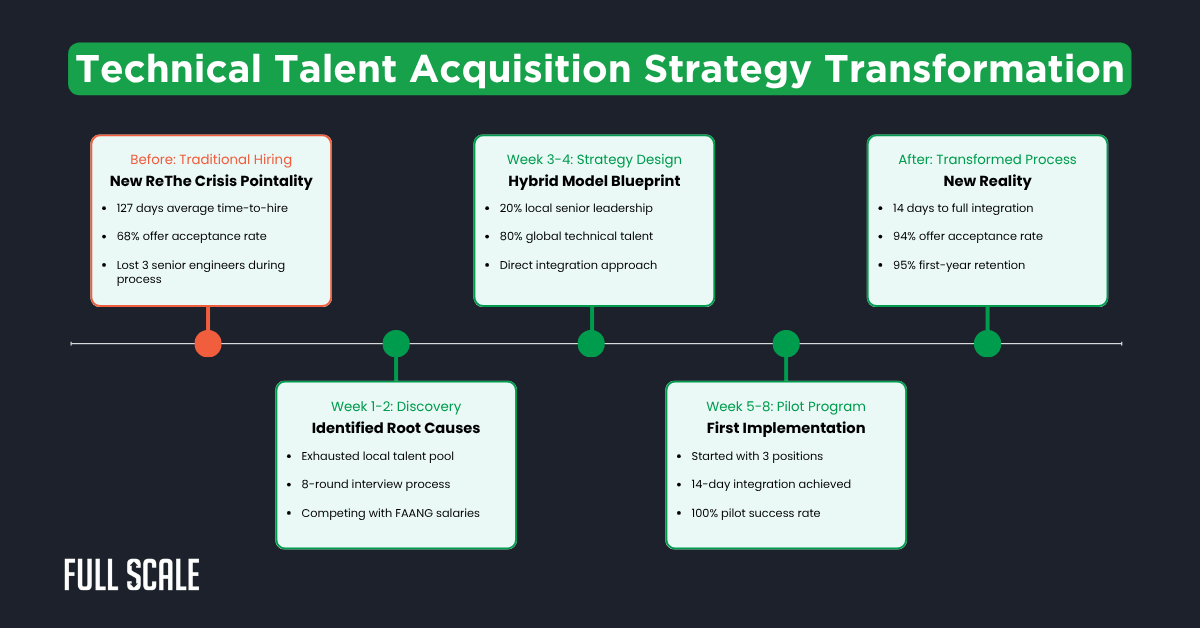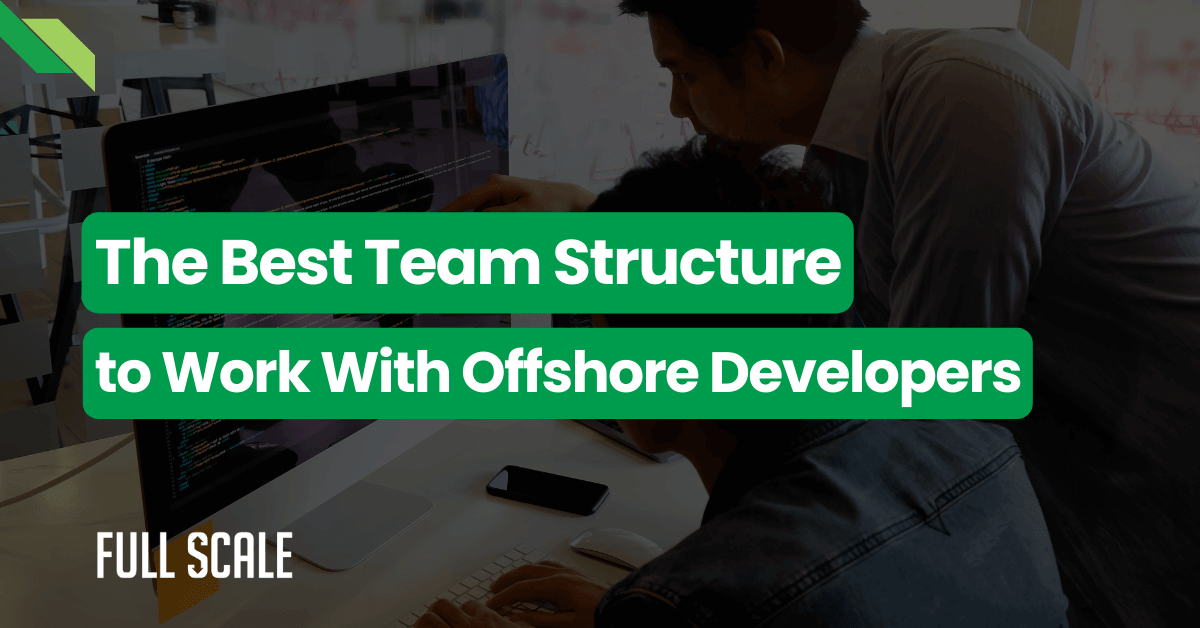Last Updated on 2025-08-26
An HR director at a growing tech company watched helplessly as three senior engineers accepted competitor offers during their four-month interview process.
This crisis forced a complete overhaul of their technical talent acquisition strategy, transforming 127-day hiring marathons into 14-day integrations through:
- Revolutionary hybrid talent pipeline combining local leadership with global excellence
- 85% reduction in time-to-hire while improving offer acceptance from 68% to 94%
- 60% cost savings with better quality and retention than traditional methods
But how does this transformation actually work?
Here’s everything you need to know about implementing a technical talent acquisition strategy that solves the developer hiring crisis:
Quick Summary: Technical Talent Acquisition Strategy
- Problem: Traditional hiring takes 4+ months and costs $35,000 per developer
- Solution: Hybrid talent pipeline combining 20% local leadership with 80% global talent
- Results: 14-day integration, 94% acceptance rate, 60% cost reduction
- Implementation: 4-phase framework over 12 weeks
- ROI: Save $962,000 annually per unfilled position
The 4-Month to 2-Week Transformation Story
Let’s explore this transformation in more detail. The HR director reached a breaking point after losing three senior engineers to competitors during lengthy interviews. Their 200-person SaaS company was bleeding talent while struggling to hire replacements.
The numbers painted a grim picture before implementing the new technical talent acquisition strategy. Average time-to-hire stretched to 127 days with only 68% offer acceptance. After implementing our hybrid talent pipeline model, integration dropped to 14 days with 94% acceptance.

This visual timeline shows how we transformed their technical talent acquisition strategy step by step. The journey from crisis to solution took just eight weeks to implement. But what made traditional hiring so broken in the first place?
Why Traditional Technical Hiring is Fundamentally Broken
The developer hiring crisis stems from outdated recruitment methods meeting modern market realities. Companies compete for the same 27% of actively looking developers while ignoring global talent pools.
Let’s examine the real cost of this broken system.
The Real Numbers Behind the Crisis
Technical hiring costs spiral beyond salary negotiations into hidden organizational damage. Every unfilled developer position costs companies $4,200 weekly in lost productivity alone.
Recent data reveals the true scope of this engineering recruitment transformation challenge:
- Technical hire costs average $32,476 per position (Glassdoor Economic Research, 2024)
- 89% of tech companies report developer shortage as top growth barrier (Stack Overflow Survey, 2024)
- Developer demand exceeds supply by 1.4 million positions globally (US Labor Statistics, 2024)
These statistics only tell part of the story. The hidden costs paint an even grimmer picture.
The Hidden Costs Nobody Calculates
Beyond recruitment fees lurk expenses that destroy budgets and morale equally. Product launches are delayed while teams burn out covering vacant positions indefinitely.
| Hidden Cost Category | Weekly Impact | Annual Impact |
| Lost Productivity | $4,200 | $218,400 |
| Technical Debt Accumulation | $2,800 | $145,600 |
| Team Overtime Burnout | $3,500 | $182,000 |
| Delayed Feature Revenue | $8,000 | $416,000 |
| Total Hidden Costs | $18,500 | $962,000 |
This table reveals why smart companies prioritize engineering team scaling strategy over traditional hiring. The math makes our technical talent acquisition strategy not just attractive but essential. So what’s the solution?
The Hybrid Talent Pipeline Model
Our technical talent acquisition strategy succeeds by combining local leadership with global technical excellence. This approach solves both quality concerns and talent shortage solutions simultaneously. Let’s break down how it works.
Core Components
The hybrid model strategically positions talent where each provides maximum value. Local senior developers guide architecture while global teams execute with precision.

This structure maximizes both local market knowledge and global technical expertise. The balance creates teams that deliver faster while maintaining quality standards. But why does this combination work so effectively?
Why Hybrid Works Better
Access to global talent pools expands possibilities beyond geographic limitations. Companies implementing our technical talent acquisition strategy report 40% faster development and 60% cost reduction.
Smart technical hiring process optimization means placing talent strategically, not randomly. Local leaders provide vision while global teams execute with specialized expertise. Now let’s see how to implement this in just two weeks.
The 2-Week Integration Playbook
Rapid developer onboarding requires structured processes that eliminate traditional bottlenecks. Our technical recruitment best practices guide ensures productivity from day one. Here’s the week-by-week breakdown:
Week 1: Foundation Setting
The first week establishes the technical foundation and team connection simultaneously. New developers receive codebase access within hours, not weeks like traditional hiring.
Days 1-3: Technical Onboarding
Environment setup completes within the first morning using automated provisioning tools. Architecture overview sessions happen daily, building a comprehensive system understanding quickly.
Days 4-7: Team Integration
Daily standup participation begins immediately, creating rhythm and accountability. Pair programming sessions accelerate knowledge transfer while building team relationships naturally.
Week 1 sets the foundation, but Week 2 is where the magic happens.
Week 2: Productivity Acceleration
Week two transforms new hires from observers into active contributors. Our technical talent acquisition strategy for offshore developer integration ensures seamless collaboration across time zones.
Days 8-10: Process Alignment
Sprint planning involvement starts with observation, then moves to active participation. Documentation contributions begin with README updates, progressing to architectural decision records.
Days 11-14: Full Integration
Independent ticket completion demonstrates readiness for autonomous work. Peer code reviews establish the developer as a trusted team member.
With the playbook clear, let’s explore the complete implementation framework.
Implementation Framework
Building your own technical talent acquisition strategy for developer shortage solutions starts with an honest assessment. This framework transforms hiring from reactive scrambling to proactive talent development. Follow these four phases:
Phase 1: Audit Current State (Week 1)
Document your actual metrics before implementing any changes or improvements. Most companies discover their true time-to-hire exceeds their estimates by 40%.
Calculate total costs including recruiter fees, interview time, and productivity losses. Map skill gaps between current team capabilities and project requirements carefully.
Phase 2: Build Hybrid Infrastructure (Weeks 2-3)
Define clear criteria for local versus global role placement decisions. Establish communication protocols that ensure seamless collaboration across all locations.
Technology setup includes collaboration tools, development environments, and security protocols. Create onboarding templates that standardize the integration process for consistency.
Phase 3: Launch Pilot Program (Weeks 4-8)
Start small with two or three positions to test your technical talent acquisition strategy. Measure integration velocity using daily check-ins and weekly milestone reviews.
Gather feedback from both new hires and existing team members continuously. Refine processes based on real-world results, not theoretical planning.
Phase 4: Scale Success (Weeks 9-12)
Expand gradually to full hiring needs once the pilot proves successful. Automate repetitive processes like environment setup and access provisioning.
Build talent pipeline reserves to maintain a consistent candidate flow. Establish performance metrics that measure both individual and team success.
Now let’s examine the financial impact of this transformation.
ROI Calculations That Matter
Financial analysis proves our technical talent acquisition strategy ROI exceeds traditional hiring significantly. The numbers tell a compelling story for CFOs seeking cost optimization.
Technical Hiring ROI Calculator
This calculator demonstrates real savings when implementing our technical talent acquisition strategy. Input your specific numbers to see the potential impact on your organization. Let’s break down the comparison:
Cost Comparison: Traditional vs. Hybrid
Traditional hiring creates compound costs through delays, turnover, and inflated salaries. Our hybrid models reduce expenses while accelerating team growth and productivity.
The data speaks clearly about engineering recruitment transformation benefits:
| Metric | Traditional Hiring | Full Scale Hybrid Model | Improvement |
| Cost per hire | $35,000 | $5,000 | 86% reduction |
| Time to productivity | 3-6 months | 2-4 weeks | 85% faster |
| First-year turnover | 22% | 5% | 77% better retention |
| Total first-year cost/developer | $180,000 | $65,000 | 64% savings |
But cost savings are just the beginning.
Productivity Gains
Beyond cost savings, our technical talent acquisition strategy delivers measurable performance improvements immediately. Development velocity increases 40% through expanded talent pools and timezone advantages.
Feature delivery accelerates 3x when teams operate without constant hiring distractions. Quality metrics improve through dedicated QA resources and peer review processes.
Of course, any new approach faces skepticism. Let’s address the common concerns.
Common Objections Addressed
Every technical talent acquisition strategy for tech talent shortage solutions faces skepticism initially. We address these concerns directly with data and proven results.
“Communication will be impossible.”
Modern collaboration tools eliminated geographic barriers years ago in tech. Structured overlap hours ensure real-time collaboration when needed most.
Direct integration prevents the telephone game common in traditional outsourcing. Teams report better documentation and clearer communication than co-located groups.
“Quality will suffer.”
Our rigorous vetting processes ensure onlythe top 3% of applicants join teams. Code review standards remain identical regardless of developer location.
Global talent pools often provide specialized expertise unavailable locally. Quality metrics from hybrid teams consistently match or exceed traditional teams.
“Management overhead will increase.”
Properly structured hybrid teams actually reduce management burden significantly. Self-organizing teams with clear protocols require less daily oversight.
Managers spend less time recruiting and more time building products. Our technical talent acquisition strategy and hiring process optimization frees leadership for strategic work.
So what makes Full Scale’s approach different?
The Full Scale Advantage
We pioneered the direct integration model for offshore developer integration success. Our technical talent acquisition strategy eliminates traditional outsourcing problems completely.
What Makes Our Hybrid Model Different
Direct integration means developers work as your employees, not contractors. Pre-vetted talent passes our 3% acceptance rate screening process.
Cultural alignment ensures English proficiency and collaborative mindset from day one. Career development programs achieve 95% developer retention versus industry standards.
Getting Started
Begin with a free talent strategy consultation to assess your needs. Custom hybrid team design aligns with your specific technical requirements.
Risk-free pilot programs let you experience the model before scaling. Full implementation support ensures a smooth transition from traditional to hybrid hiring.
Ready to transform your hiring process? Here’s your roadmap.
Your 30-Day Action Plan
Transform your talent strategy with our proven technical talent acquisition strategy and recruitment best practices roadmap. Each week builds toward sustainable hiring transformation.
Week 1: Assessment
Calculate current hiring metrics, including time, cost, and success rates. Identify immediate needs and bottlenecks in your current process. Define clear success criteria for your hiring transformation initiative.
Week 2: Strategy Design
Map your ideal hybrid team structure, balancing local and global talent. Set integration protocols and communication standards for seamless collaboration. Prepare onboarding materials that accelerate new developer productivity.
Week 3: Pilot Launch
Start with one or two positions to test your new technical talent acquisition strategy approach. Implement daily check-ins to monitor progress and address issues quickly. Track integration metrics to measure success against traditional hiring.
Week 4: Scale Decision
Review pilot results against your defined success criteria objectively. Plan expansion based on lessons learned during pilot phase. Optimize processes before scaling to full implementation.
To support your implementation, we’ve created practical tools you can use immediately.
Use Full Scale’s Templates
These practical tools accelerate your technical talent acquisition strategy implementation immediately. Each template addresses specific challenges tech companies face when building hybrid teams. Use these resources to transform your hiring process from reactive to strategic.
Hybrid Team Structure Calculator
Hybrid Team Structure Calculator
Optimize your local and global talent distribution for maximum efficiency
Team Requirements
Budget and Timeline
Recommended Hybrid Structure
Team Composition Breakdown
Implementation Timeline
Use the complete hybrid team planning toolkit
Use Full TemplateThis calculator helps determine the optimal mix of local and global talent for your specific needs. Input your team size, budget, and project requirements to receive customized recommendations for role distribution.
2-Week Developer Integration Checklist
2-Week Developer Integration Checklist
Track your new developer’s integration progress day by day
Week 1: Foundation Setting
0/15 completedWeek 2: Productivity Acceleration
0/15 completedIntegration Notes
Track every step of your new developer onboarding with this comprehensive checklist. This tool ensures consistent integration experiences and helps identify bottlenecks in your onboarding process.
Communication Protocol Guide
Hybrid Team Communication Protocol Guide
Design effective communication strategies for distributed teams
Time Zone Overlap Calculator
Recommended Overlap Hours
Communication Channel Matrix
| Communication Type | Recommended Tool | Response Time | Best For |
|---|---|---|---|
| Daily Standups | Video Call (Zoom/Meet) | Real-time | Team sync and blockers |
| Quick Questions | Slack/Teams Chat | 1-2 hours | Non-urgent clarifications |
| Code Reviews | GitHub/GitLab Comments | 4-8 hours | Async feedback |
| Sprint Planning | Video Call + Shared Board | Real-time | Collaborative planning |
| Documentation | Confluence/Notion | 24 hours | Knowledge sharing |
Recommended Communication Tools
Real-time Communication
Primary: Slack or Microsoft Teams
Setup: Create channels for #general, #dev-team, #code-reviews, #daily-standup
Best Practice: Set status messages with working hours and current focus
Video Conferencing
Primary: Zoom or Google Meet
Setup: Recurring meeting links for standups and weekly syncs
Best Practice: Always record important sessions for absent team members
Project Management
Primary: Jira, Linear, or Trello
Setup: Clear ticket templates and workflow states
Best Practice: Daily ticket updates before end of work day
Golden Rules for Hybrid Team Communication
- Document decisions in writing, even after verbal discussions
- Respect async communication – not everyone needs immediate responses
- Use video for complex discussions, text for simple updates
- Establish “core hours” where everyone is available
- Rotate meeting times to share timezone burden fairly
Your Custom Communication Protocol
Establish clear communication standards for your hybrid team with this interactive guide. Define overlap hours, choose appropriate tools, and create protocols that ensure smooth collaboration across time zones.
ROI Calculation Spreadsheet
Technical Hiring ROI Calculator
Compare traditional vs hybrid hiring costs and ROI
Hiring Parameters
Cost Factors
Cost Comparison Results
Detailed Cost Breakdown
| Cost Category | Traditional Model | Hybrid Model | Difference |
|---|
5-Year Cost Projections
| Year | Traditional Costs | Hybrid Costs | Cumulative Savings |
|---|
5-Year Summary
Calculate the full financial impact of switching to a hybrid hiring model with this comprehensive spreadsheet. Compare costs, project savings, and analyze ROI across multiple scenarios to make data-driven decisions.
What’s Your Next Step?
Ready to solve your developer hiring crisis? Hire Full Scale offshore developers. Schedule a strategy call with Full Scale’s talent experts today.
Build Your Software Development Dream Team Today
FAQs: Technical Talent Acquisition Strategy
What exactly is a technical talent acquisition strategy, and how does it differ from regular hiring?
A technical talent acquisition strategy is a comprehensive approach that goes beyond filling individual positions. Unlike traditional hiring’s reactive nature, this strategy creates a sustainable pipeline of pre-vetted developers, combining local leadership with global talent pools. The result: hiring time drops from months to weeks while quality and retention improve significantly.
How can a technical talent acquisition strategy reduce hiring time from 4 months to 2 weeks?
Four key innovations make this possible: pre-vetted talent pools eliminate starting from scratch, streamlined assessments focus on practical skills over lengthy interviews, global talent access reduces competition, and automated onboarding ensures immediate productivity. Our technical talent acquisition strategy removes traditional bottlenecks at every stage.
What makes the hybrid talent pipeline different from traditional outsourcing models?
Unlike traditional outsourcing’s external contractors, our technical talent acquisition strategy integrates global developers directly into your team. They join daily standups, use your tools, and work as dedicated full-time resources. The 20/80 split ensures strategic alignment through local leadership while maximizing specialized skills and cost efficiency through global talent.
How much can companies really save with this technical talent acquisition strategy?
Companies typically see 60-70% cost reductions through our technical talent acquisition strategy. This includes eliminating $4,200 weekly vacancy costs, 20-30% recruitment fees, and reducing 22% turnover rates to 5%. Combined with faster productivity and reduced overhead, first-year ROI often exceeds 200%.
What are the first steps to implementing a technical talent acquisition strategy in my company?
Start by auditing current metrics: time-to-hire, cost per hire, and turnover rates. Identify roles best suited for the hybrid model—typically specialized technical positions. Design your custom technical talent acquisition strategy through consultation, then launch a 2-3 position pilot program to prove the model before scaling company-wide.

Matt Watson is a serial tech entrepreneur who has started four companies and had a nine-figure exit. He was the founder and CTO of VinSolutions, the #1 CRM software used in today’s automotive industry. He has over twenty years of experience working as a tech CTO and building cutting-edge SaaS solutions.
As the CEO of Full Scale, he has helped over 100 tech companies build their software services and development teams. Full Scale specializes in helping tech companies grow by augmenting their in-house teams with software development talent from the Philippines.
Matt hosts Startup Hustle, a top podcast about entrepreneurship with over 6 million downloads. He has a wealth of knowledge about startups and business from his personal experience and from interviewing hundreds of other entrepreneurs.




